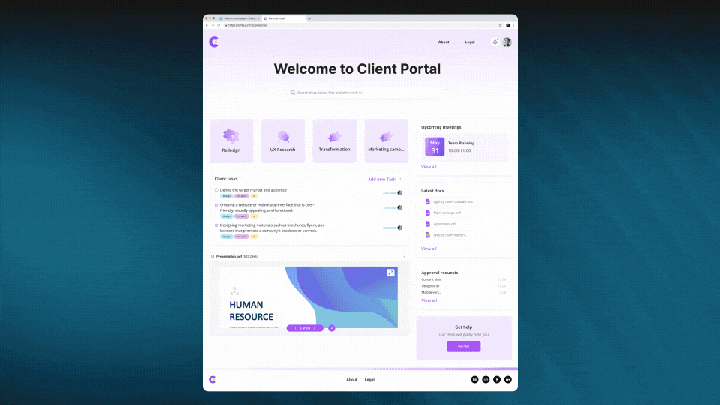How To
A Deep Dive into the Top 9 Digital Transformation Challenges
Discover and overcome the primary challenges in digital transformation

- January 31, 2024
- Updated: July 2, 2025 at 12:07 AM

We all understand that digital transformation is an ongoing and dynamic process. Consumer expectations and the tech landscape have evolved rapidly over time, and now, there are more new digital technologies than ever.
As all companies recognize the need for digital transformation, each must face some form of obstacles or hurdles when embarking upon their transformation journeys. Here, we highlight several top digital transformation challenges companies encounter while embarking on their digital journey and provide strategies on how to effectively overcome them.
Challenge 1: The organization’s culture isn’t very flexible
Change happens rapidly in society, and this requires companies and brands to adapt quickly as well. Maintaining stability while adapting quickly to new technology is at the core of corporate agility.
Successful brands prioritize business processes that focus on the customer journey and embrace change as an opportunity for business growth rather than holding onto outdated systems that no longer meet these objectives. An innovation culture must also be fostered within organizations so new technologies are utilized across their operations and integrated seamlessly.
Imagine an outsourcing agency used to employing conventional project management methodologies; when client demand shifts toward more flexible and adaptive approaches, however, their processes struggle to adapt rapidly enough in response. An unwillingness to break away from established norms jeopardizes project timelines while hampering responsiveness to client demands in an ever-evolving marketplace.
Launching an adaptable culture transforms an agency into an agile and responsive entity, with projects flowing more smoothly due to efficient workflows and a collaborative mindset. Tailoring solutions specifically to client requests becomes much simpler, as does timely delivery while adhering to agile principles, which helps the team navigate digital transformation challenges seamlessly, becoming industry pioneers along the way.
Challenge 2: Not enough technological capabilities
The adoption of new tools is one of the most common digital transformation challenges. Modern technologies give organizations an invaluable strategic advantage, yet many lack the infrastructure, knowledge, or resources needed to effectively utilize modern technologies. Businesses without technological capabilities often suffer as a result.
From outdated IT infrastructure and personnel who lack proficiency with emerging technologies to failing to innovate efficiently or meet the evolving demand of the digital marketplace, businesses without new tools and technological capabilities face multiple disadvantages in business operations. This handicap prevents innovation, streamlining operations, and meeting changing customer demands effectively.
At one time, most recruiting agencies developed applications oriented around job vacancies. Now that job candidates are more scarce and receive numerous job offers than before; their needs can no longer be satisfied by these outdated tools; as a result, companies decided to develop systems using modernized tech stacks instead.
Recognizing modern digital technologies is key for business expansion. Equipped with enhanced capabilities, modern tech gives organizations a competitive advantage by streamlining operations and making data-driven decisions with precision when client needs or market trends emerge. Beyond internal improvements, companies expanding service horizons may demonstrate adaptability towards serving various client bases while encouraging innovative thought through technological leaps that spark creative breakthroughs that foster an environment for creativity!
Challenge 3: Evolution of customer needs

Most organizations nowadays need help meeting evolving customer needs. For sure, this happens because of the fast development of the customer service industry. And if our existing systems change and improve all the time, then why wouldn’t customer needs change along the way?
Companies should invest their time and money into digital transformation projects constantly if they want to keep up with customer needs and provide them with modern and high-quality customer journeys.
If you take a look at a marketplace that went through a digital transformation process a few years ago and changed nothing since that time, then most probably, it has some problems keeping its clients today. Why? Because a few years ago, people only cared about a straightforward shopping experience; now, with the continuous evolution of modern technologies, customers expect tailored recommendations, real-time order tracking capabilities, eco-friendly packaging solutions, and much more. Of course, it takes more work to satisfy all those needs with some old-school systems and manual processes. That’s why only those businesses that are constantly trying to keep up with customer needs and new technologies will stay at the top of the industry’s “food chain.”
Challenge 4: Security concerns
If you decide it is time for your company to go digital and embrace remote working arrangements and cloud solutions – get ready for some additional risks. Once you make this decision, you need to take care of additional security measures and protect all your sensitive data from cyberattacks. Those failing to do so often meet various serious consequences. So, take care of the company’s cybersecurity before losing your valuable assets and customer loyalty.
In case you’re still not convinced that security concerns could become a serious challenge, let’s imagine the following: a successful financial organization decides to go digital and transform to cloud-based systems. While increasing its operational efficiencies and improving some digital processes, the company forgets about implementing adequate cybersecurity measures. What happened next? The customer data and financial records became vulnerable, which led to huge damage to the company’s reputation. So, while hopping on your digital transformation journey, it’s essential to take care of all the crucial organizational structures.
Robust cybersecurity is important for an organization’s digital transformation. We won’t tire of repeating that taking care of all these measures and dealing with challenges will protect your data, improve your brand image, and foster client trust.
Challenge 5: Inadequate digital transformation strategy

Do you know why your company should switch from legacy systems to digital ones? Do you have an organization’s digital transformation strategy to introduce complex and advanced systems (or a need for it)? Do you have the right tools to migrate from your old systems to new ones, and have you created a comprehensive financial strategy?
Answering these questions is essential before you implement a digital transformation process. It is not possible to have a successful project in digital transformation without having a clearly defined change management strategy. Avoid false buzzwords or assumptions. Legacy systems play an essential part in the integration of new technologies. You can choose from the many digital transformation models based on where your business needs to improve and which areas need upgrading.
Imagine that a manufacturing company seeking digital transformation invests in technologies without fully comprehending their individual needs and objectives, leading them down an ineffective path toward implementation of these tools into their daily processes. Employees struggle with adapting, efficiency gains are scarcely seen through, and employee morale suffers due to this disjointment in the digital era and landscape. Due to an incomplete digital and change management strategy, companies’ transformative potential is diminished; therefore, it would be prudent for businesses to reexamine and adapt their digital transformation plan before investing or adapting it.
Creating and bringing to life an effective change management strategy is crucial to business success. By following an organized roadmap, businesses can better align technological investments with organizational digital transformation goals; processes become more streamlined while employees gain essential skills that facilitate an easier transition process. Furthermore, a well-defined strategy creates an atmosphere of intentional transformation where digital initiatives serve a strategic function.
Challenge 6: Lack of employee empowerment and internal involvement
Transformation roadmaps and digital initiatives must both be flexible in order to remain adaptable in response to digital transformation efforts. Although IT/engineering plays an essential part in digital transformation processes, ultimately, all parties involved need to ensure that successful implementation, adaptations, and iterative changes take place smoothly – digital solutions present both people and technology with digital transformation challenges that need addressing simultaneously. The digital transformation initiative can radically change the company’s business model, including workgroups and job titles. It also changes long-established processes. People feel threatened, insecure, and fearful of their job security when these changes occur.
Take, for instance, a retail company undertaking digital transformation programs by adopting an advanced inventory management system. While its IT team excels at the implementation of this new tech, frontline staff who perform daily operations, feel left out as roles and responsibilities change without adequate communication or training, creating resistance among staff.
Early and in-depth involvement by digital transformation leaders and CEOs with all company employees will increase engagement. People will become aware of new digital solutions’ effect on business operations; its digital success relies on cross-functional teamwork requiring leadership and empathy skills as essential ingredients of team success; success will occur more readily if company culture supports and engages in its digital transformation efforts.
Challenge 7: Bad data management
Data challenges impede many firms, even as trustworthy information is crucial for digital transformation. Amalgamating systems may prove challenging when there are siloed structures present.
Before selecting software to manage your data analytics, a blueprint of it should be drawn. This will enable you to identify areas that require cleaning, normalizing, or transfer to ensure its continued value for insights.
Finding new technologies and data sources that could increase software insights becomes much simpler with an organized data blueprint.
Imagine this: a marketing agency goes through a digital transformation process to strengthen campaign analytics. Their client data was previously scattered amongst various platforms and presented challenges when consolidating for campaign optimizations as well as real-time decision-making capabilities or timely performance metrics for clients.
Dealing effectively with data issues is at the core of an agency’s campaign effectiveness. Creating an effective data strategy and integrating client information for real-time analytics and informed decision-making – providing clients with real-time insight, optimizing campaigns in real-time, and demonstrating tangible data-driven results; this not only ensures client satisfaction but also positions them as pioneers within today’s marketing ecosystem.
Challenge 8: Lack of sufficient skill and talent
Your company could experience difficulty hiring enough qualified workers for its digital transformation initiatives due to either insufficient candidates with experience or insufficient knowledge among new hires. Therefore, additional spending might need to go toward training and development initiatives as a means to bridge any digital skill gap between what your staff possesses and your needs.
Digitizing requires numerous skill sets ranging from technical acumen to business acumen; companies may struggle with hiring employees who possess all these capabilities for digital transformation projects or finding qualified applicants for roles like software development and data analysis.
Firms aiming to fully harness digital transformation must address staff and skill shortages effectively if they want to fully take advantage of its promise in order to exploit its full benefits. Doing this ensures long-term viability, competitive position strengthening, and continuous improvement, as well as a productivity boost for the workforce! Having qualified personnel onboard allows companies to boldly adopt cutting-edge technologies while exploring uncharted territories fearlessly, taking full advantage of its promise; winning this talent/skill battle means greater competitiveness and innovation sustainability within a digital transformation context!
Challenge 9: Siloed decision-making

This is the last digital transformation challenge on our list. Siloed decision-making that limits visibility across an organization and information flow can present businesses with numerous roadblocks to successful digital transformation. To overcome such hurdles, internal barriers should be broken down to facilitate teamwork; additionally, an environment of candor within policymaking processes needs to be fostered for maximum success in digital transformation efforts.
Imagine a tech firm seeking digitization: software engineers focus on expanding platform capabilities while marketers develop engaging strategies, but due to disjointed product launches caused by disparate teams failing to collaborate or communicate properly, customers become disoriented because marketing materials no longer reflect recent software capabilities while siloed decision making prevents stakeholders from working collaboratively towards offering customers an exceptional and seamless customer experience.
Breaking siloed decision-making can change a company’s digital transformation journey, as doing away with silos promotes cross-functional collaboration and ensures decisions reflect all goals within an organization. Successfully dealing with this challenge leads to coordinated efforts between teams, cohesive product launches, and improved internal and external communications, ultimately leading to higher innovation efficiency and customer satisfaction for businesses that cultivate openness and transparency within decision-making – ultimately leading to successful digital transformation efforts.
How to overcome digital transformation challenges?
Digital transformation presents businesses with numerous obstacles; these range from common challenges like aligning company culture with emerging tech gaps and managing complex data intricacies to aligning employee values to emerging digital advancements, among others. Overcoming such organizational challenges requires more than good intentions: successful transformation requires tools designed specifically for its process.
FuseBase (formerly Nimbus) provides an effective software solution to effectively lead digital transformation projects while overcoming potential roadblocks along their journey.
FuseBase provides client-driven businesses with a one centralized system and indispensable collaboration hub designed specifically to simplify client interactions and improve customer engagement by consolidating communication channels, tools, and content into one easy platform they can quickly use to streamline workflows and delight their client base.
If your company’s digital transformation requires and prioritizes customer happiness and adaptation, then you will find this software extremely valuable.
How can FuseBase (formerly Nimbus) help you deal with all the digital transformation challenges?

FuseBase provides various powerful features, tools, and new systems, making it an invaluable solution for businesses navigating a complex digital transformation journey. Here, we explore some of these features that may assist your scalable business with digital transformation while offering custom-tailored solutions designed specifically to support digitization efforts across its journey and beyond.
- Client Portals. FuseBase stands out with Client Portal by creating sophisticated yet branded spaces to facilitate efficient project management. These portals eliminate such a significant challenge as siloed decision-making by centralizing updates, approvals, and communication. Once an IT firm went online, its organizational structure improved, marketing materials quickly started featuring updates about software features, launches were no longer confusing or mistimed, teams worked efficiently without data leakage disrupting teamwork processes, and client experiences improved significantly while remaining more transparent than ever.
- Data Collection. FuseBase provides an essential data collection feature to expedite client information-gathering processes quickly and efficiently by seamlessly embedding forms, surveys, and analytics onto pages for data acquisition purposes. FuseBase’s real-time data collection capability empowers agencies and businesses to improve data security and quickly capture reactions, preferences, and expectations as quickly as they alter strategies to respond to changing target audience requirements in real time, thus helping businesses meet client demands quickly.
- Knowledge Base. Knowledge base feature can serve as an efficient solution to poor data management by offering an organized platform for creating searchable wikis, documentation, and guides. Institutional knowledge must be protected at all costs to reduce risks of data loss while strengthening overall management practices. Knowledge bases form the cornerstone for informed decision-making and effective collaboration. Imagine an outsourcing agency using multiple platforms for project information storage without a knowledge base solution in place to simplify searching key details and avoid data oversights. Failing to access a central knowledge repository made obtaining essential details time-consuming and inefficient when searching various systems, leading to potential inefficiencies as well as data mistakes. FuseBase makes it simple for businesses to organize all project information into an easily searchable knowledge base for quick retrieval, reduced risks of missing crucial details, and overall improved data management. Employees gain easy access to any details needed, facilitating smooth collaboration and informed decision-making throughout a project’s lifespan.
- Collaboration and Communication features. FuseBase provides businesses with powerful Collaboration and Communication features to bridge talent and skills gaps with real-time comments and chats, video/audio recording/playback capabilities, and real-time collaboration features that allow employees to meet them head-on. In the workplace setting, FuseBase promotes efficient team communications for maximum productivity while at the same time nurturing a digital world conducive to a collaborative culture for the seamless adoption of digital transformation initiatives by employees.
Summing up
2024 is an essential year for organizations looking to maintain a competitive edge in an increasingly digital economy in terms of digital transformation challenges they must surmount to stay viable. Technological developments and digital transformations continue their rapid ascent while businesses shift online rapidly at increasing rates; having an effective digital presence to reach out to customers has never been more crucial.
Digital transformation enables organizations to increase cost efficiency and effectiveness, leading to increased profits as well as helping develop innovative new business models and revenue streams necessary to remain competitive in today’s environment and digital future. And if you want to get the most out of your business’s digital transformation journey, FuseBase stands ready to support you with a seamless, efficient, and trouble-free experience.
Latest from Sabina Sher
- Understanding VoIP: Basics and Benefits of Using in 2024
- How to Get a Business Phone Number: Top 7 Apps for Customer Service and E-commerce Platforms in 2024
- Unlocking Privacy: How to Get a Second Phone Number for Enhanced Security and Communication
- Dialing Success: Top 7 VoIP Providers for Small Businesses
You may also like
 News
NewsThe finale of Stranger Things will be shown in theaters and has already sold more than 1 million tickets
Read more
 News
NewsCreate retro-futuristic reels with Premiere Pro + Firefly
Read more
 News
NewsPluribus’ ending could have been much more bland, but an Apple executive suggested something else
Read more
 News
NewsIf there are no more Avatar movies, James Cameron knows how the story will continue
Read more
 News
NewsApple doesn't want its foldable iPhone to have wrinkles on the screen: is there a solution?
Read more
 News
NewsWe already know who will be the director of the Sleeping Dogs movie
Read more